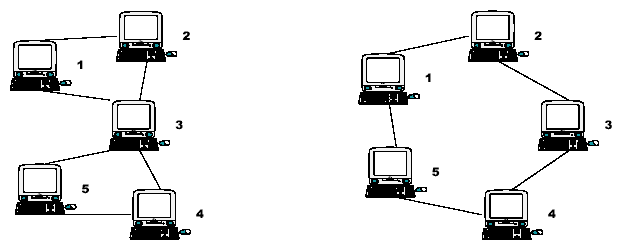poj 1523 SPF(无向图求关节点)
2015-03-22 22:15
495 查看
SPF
Consider the two networks shown below. Assuming that data moves around these networks only between directly connected nodes on a peer-to-peer basis, a failure of a single node, 3, in the network on the left would prevent some of the still available nodes from communicating with each other. Nodes 1 and 2 could still communicate with each other as could nodes 4 and 5, but communication between any other pairs of nodes would no longer be possible. Node 3 is therefore a Single Point of Failure (SPF) for this network. Strictly, an SPF will be defined as any node that, if unavailable, would prevent at least one pair of available nodes from being able to communicate on what was previously a fully connected network. Note that the network on the right has no such node; there is no SPF in the network. At least two machines must fail before there are any pairs of available nodes which cannot communicate.  Input The input will contain the description of several networks. A network description will consist of pairs of integers, one pair per line, that identify connected nodes. Ordering of the pairs is irrelevant; 1 2 and 2 1 specify the same connection. All node numbers will range from 1 to 1000. A line containing a single zero ends the list of connected nodes. An empty network description flags the end of the input. Blank lines in the input file should be ignored. Output For each network in the input, you will output its number in the file, followed by a list of any SPF nodes that exist. The first network in the file should be identified as "Network #1", the second as "Network #2", etc. For each SPF node, output a line, formatted as shown in the examples below, that identifies the node and the number of fully connected subnets that remain when that node fails. If the network has no SPF nodes, simply output the text "No SPF nodes" instead of a list of SPF nodes. Sample Input 1 2 5 4 3 1 3 2 3 4 3 5 0 1 2 2 3 3 4 4 5 5 1 0 1 2 2 3 3 4 4 6 6 3 2 5 5 1 0 0 Sample Output Network #1 SPF node 3 leaves 2 subnets Network #2 No SPF nodes Network #3 SPF node 2 leaves 2 subnets SPF node 3 leaves 2 subnets Source Greater New York 2000 |
1) 如何判断顶点v 是顶点u 的祖先结点;
2) 如何判断边(v, u)是回边;
3) 如何判断顶点v 是顶点u 的儿子结点。
这3 个问题都是在深度优先搜索函数dfs 中解决的。从顶点u 出发进行DFS 搜索时,要判断
其他每个顶点v 是否跟u 是否邻接、是否未访问过。如果v 跟u 邻接,则在生成树中就是2 种情
况:
① 如果顶点v 是顶点u 的邻接顶点,且此时v 还未访问过,则v 是u 的儿子结点;
② 如果顶点v 是顶点u 的邻接顶点,且此时v 已经访问过了,则v 是u 的祖先结点,且(v, u)
就是一条回边。
#include <cstdio>
#include <iostream>
#include <cstring>
#include <cmath>
#include <algorithm>
#include <string.h>
#include <string>
#include <vector>
#include <queue>
#define MEM(a,x) memset(a,x,sizeof a)
#define eps 1e-8
#define MOD 10009
#define MAXN 10010
#define INF 99999999
#define ll __int64
#define bug cout<<"here"<<endl
#define fread freopen("ceshi.txt","r",stdin)
#define fwrite freopen("out.txt","w",stdout)
using namespace std;
void read(int &x)
{
char ch;
x=0;
while(ch=getchar(),ch!=' '&&ch!='\n')
{
x=x*10+ch-'0';
}
}
int Edge[1010][1010];//邻接矩阵 存储边
int vis[1010];
int nodes;//顶点数目
int tmpdfn;//dfs过程中记录当前深度优先搜索序数
int dfn[1010];//每个顶点的dfs的值
int low[1010];//每个顶点的low值 根据该值来判断是否是关节点
int son;//根节点的子女结点的个数(如果大于2 则根节点是关节点)
int subnets[1010];//记录每个节点(去掉该节点后)的连通分量个数
void dfs(int u)
{
for(int v=1;v<=nodes;v++)
{
//v跟u邻接
//1 v是u的祖先结点 这样(v,u)就是一条回边 2v是u的儿子节点
if(Edge[u][v])
{
if(!vis[v])
{
vis[v]=1;
tmpdfn++;
dfn[v]=low[v]=tmpdfn;
dfs(v);//dfs(v)执行完毕后 low[v]值已求出
//回退的时候 计算顶点u的low值
low[u]=min(low[u],low[v]);
if(low[v]>=dfn[u])
{
if(u!=1) subnets[u]++;
if(u==1) son++;
}
}
//此前v已经访问过了 v是u的祖先结点
else low[u]=min(low[u],dfn[v]);
}
}
}
void init()
{
low[1]=dfn[1]=1;
tmpdfn=1;
son=0;
MEM(vis,0);
vis[1]=1;
MEM(subnets,0);
}
int main()
{
// fread;
int u,v;
bool flag;
int cs=1;
while(1)
{
scanf("%d",&u);
if(u==0) break;
MEM(Edge,0);
nodes=0;
scanf("%d",&v);
if(u>nodes) nodes=u;
if(v>nodes) nodes=v;
Edge[u][v]=Edge[v][u]=1;
while(1)
{
scanf("%d",&u);
if(u==0) break;
scanf("%d",&v);
if(u>nodes) nodes=u;
if(v>nodes) nodes=v;
Edge[u][v]=Edge[v][u]=1;
}
if(cs>1) puts("");
printf("Network #%d\n",cs++);
init();
dfs(1);
if(son>1) subnets[1]=son-1;
flag=0;
for(int i=1;i<=nodes;i++)
{
if(subnets[i])
{
flag=1;
printf(" SPF node %d leaves %d subnets\n",i,subnets[i]+1);
}
}
if(!flag) printf(" No SPF nodes\n");
}
return 0;
}
相关文章推荐
- POJ1523 SPF[无向图割点]
- poj 1523 SPF(无向图点的连通性问题)
- poj 1523 SPF 无向图关节点
- poj 1523 SPF 无向图关节点
- POJ 1523 SPF(无向图求割点,去割点形成子图数)
- POJ1523 SPF (无向图求割点)
- POJ 1523 SPF Tarjan求无向图割点
- 【连通图|关节点】POJ-1523 SPF
- POJ 1523 SPF(寻找关节点)
- Zoj 1119 POJ 1523 SPF 求关节点及删除关节点会出现多少个连通分量 Tarjan算法
- POJ-1523 SPF 无向图求割点
- poj 1523 SPF 无向图求割点
- POJ 1523 SPF(无向图连通分量求割点)
- poj 1523 SPF 无向图求割点
- POJ 1523 SPF (无向图求割点 tarjan算法)
- POJ 1523 SPF 无向图求割点
- POJ 1523 SPF tarjan求割点
- POJ-1523(无向图割点将图分成几部分)
- POJ 1523 SPF
- POJ 1523 SPF
